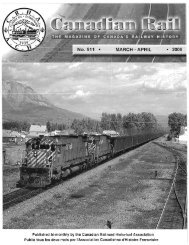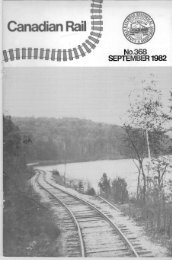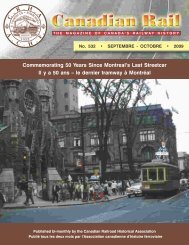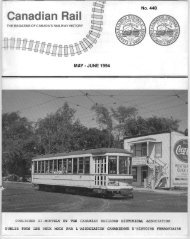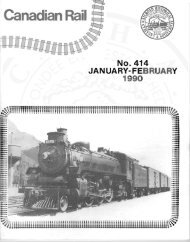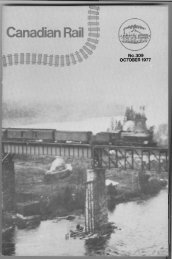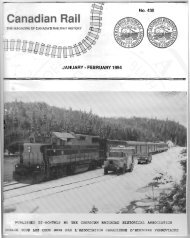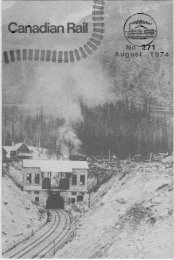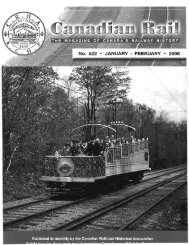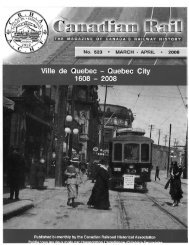Canadian Rail_no536_2010 - Le musée ferroviaire canadien
Canadian Rail_no536_2010 - Le musée ferroviaire canadien
Canadian Rail_no536_2010 - Le musée ferroviaire canadien
You also want an ePaper? Increase the reach of your titles
YUMPU automatically turns print PDFs into web optimized ePapers that Google loves.
RAIL CANADIEN • 536 100<br />
MAI – JUIN <strong>2010</strong><br />
CNR U2g 4-8-4 6207 was part of an order of “war baby” Northerns built by Montreal Locomotive Works in 1942. As they were<br />
delivered, they were immediately placed in service between Moncton and Halifax supplementing their older 6100 series sisters. In<br />
1942, heavy wartime passenger and freight traffic saw the Northerns placed into service on the entire Montreal – Halifax run. In this<br />
postwar view from August 1949, Northern 6207 has the westbound “Ocean Limited” well in hand leaving Halifax for the west.<br />
Photo: Kenneth S. MacDonald.<br />
La locomotive 4-8-4 U2g no 6207 du CNR, construite par la Montreal Locomotive Works en 1942, faisait partie de la commande des<br />
Northern du temps de la guerre. Au moment de leur livraison, elles furent mises en service entre Moncton et Halifax, en renfort de<br />
leurs sœurs de la série 6100. On en a observé aussi en 1942, à la tête de trains de passagers et de marchandises entre Montréal et<br />
Halifax. On aperçoit, sur cette photo d’après-guerre de 1949, la Northern no 6207 à la tête de l’Ocean Limited en direction ouest.<br />
Photo : Kenneth S. MacDonald.<br />
From Montbec (about two miles east of St<br />
Hyacinthe) to Chaudiere (about two miles west of<br />
Charny, our train rolls over the former Drummond<br />
Country <strong>Rail</strong>way. Built in the 1890s, the Intercolonial<br />
acquired the line in 1898 as part of a push by the Laurier<br />
government to extend the government owned system to<br />
Montreal. The receding headlights of private vehicles on<br />
Autoroute Jean <strong>Le</strong>sage, which chases the railway<br />
between Montreal and Quebec City, shows that the<br />
railway can still beat the horseless carriage for speed and<br />
comfort, and the train passenger almost feels sorry for the<br />
harried motorist as he is left behind in his desperate hurry<br />
to beat the truck traffic.<br />
Track abandonments east of Charny ended the<br />
picturesque run along the banks of the St Lawrence to the<br />
<strong>Le</strong>vis station and the Ocean now runs inland from the<br />
river. The Dominion government purchased most of the<br />
section from Charny to Riviere du Loup from the Grand<br />
Trunk <strong>Rail</strong>way in 1879. The Grand Trunk happily turned<br />
over the under maintained and thinly traffic line to the<br />
ICR and used the funds to extend its main line from Port<br />
Huron, Michigan to Chicago.<br />
It is only at Rivière du Loup that the Ocean<br />
begins travelling over the original Intercolonial line. A<br />
rail link to the Maritimes built by the Dominion<br />
government was one of the main demands of the east<br />
coast residents made when discussing the confederation<br />
of the British provinces in the 1860s. While Nova Scotia<br />
and New Brunswick politicians had espoused the project<br />
for the previous two decades, the project floundered as<br />
neither private capitalists or the British government was<br />
willing to finance on the line through the sparsely<br />
populated areas of New Brunswick or eastern Quebec.<br />
The notion of government construction and ownership<br />
came from the Maritimes that had a tradition of this; the<br />
Nova Scotia <strong>Rail</strong>way and the European & North



